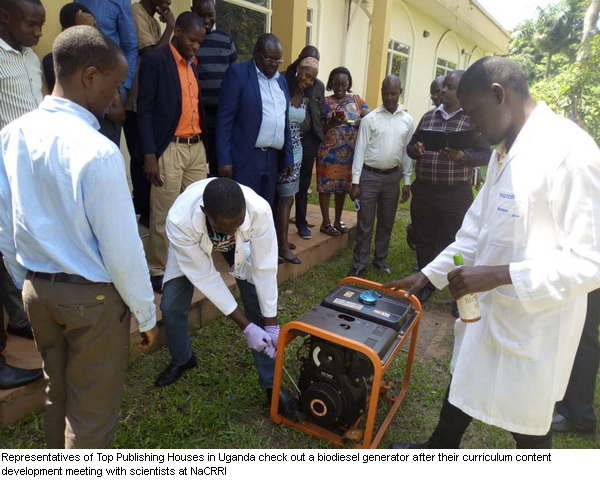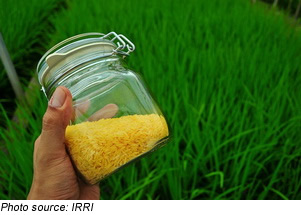
CROP BIOTECH UPDATE
---------------------------------------------------------------------------
A weekly summary of world developments in agri-biotech for developing countries, produced by the Global Knowledge Center on Crop Biotechnology, International Service for the Acquisition of Agri-biotech Applications SEAsiaCenter (ISAAA)
---------------------------------------------------------------------------
July 10, 2019
In This Week’s Issue:
News
Africa
Nigeria Needs More Community Engagement on GM Cotton from Agricultural Extension Workers
Curriculum Reforms in Uganda Integrate Modern Biosciences
Mozambique to Gain from Using GM Maize, Research Reveals
Americas
Researchers Map Vegetable Family Tree
Asia and the Pacific
Breakthrough Finds Plant Nutrient Detector
Europe
Scientists Discover How Plants Breathe
Change Needed for Europe's Assessment and Approval Process for Genome‐Edited Crops
Research
Golden Rice Has Same Nutrients as Traditional Rice Except for the Increased Provitamin A Content
New Breeding Technologies
EU Commissioner Vytenis Andriukaitis on the Potential of Gene Editing
Genome Editing Could be Used to Engineer Resistance to Virus and Cold-induced Sweetening in Potato
Scientists Finally Record Successful Mitochondrial DNA Editing in Plants
Researchers Use Virus in Wheat and Maize Genome Editing
Beyond Crop Biotech
Japanese Geneticists Favor New Policies for Genome Editing Applications, Survey
Announcements
6th Plant Genomics and Gene Editing Congress: Asia (10% Discount for CBU Subscribers)
----
NEWS
----
Africa
NIGERIA NEEDS MORE COMMUNITY ENGAGEMENT ON GM COTTON FROM AGRICULTURAL EXTENSION WORKERS
In 2018, two Bt cotton varieties have been approved for commercialization by the Nigerian federal government. The GM cotton varieties, developed by Mahyco Nigeria Private Ltd. in collaboration with the Institute for Agricultural Research (IAR) at Ahmadu Bello University in Zaria, were designed to address the major yield losses in cotton caused by the bollworm insect pest. Currently, over a thousand farmers are given free seeds and are participating in the GM crop's final trials conducted in different cotton zones in Nigeria. Dr. Rose Maxwell Gidado, country coordinator for the Nigeria chapter of the Open Forum on Agricultural Biotechnology (OFAB) states that the "full scale commercialization" shall take place in 2020.
However, some community leaders continue to discourage local farmers from using the pest-resistant GMO cotton seeds. Furthermore, the efforts of the extension officers to clarify the farmers' doubts regarding the genetically enhanced seeds seem to be insufficient. Direct community engagement by agricultural extension workers and farm leaders is then called for to enhance the acceptance and use of the GMO cotton seeds by Nigerian farmers.
Visit Cornell University's Alliance for Science to know more.
Years of relentless efforts led by Uganda Biosciences Information Center (UBIC) to integrate modern biosciences into Uganda's middle/secondary schools' curriculum were finally rewarded. Uganda's Ministry of Education and Sports endorsed a new curriculum for agriculture course unit that requires students to be trained on modern biosciences including modern biotechnology applications.
UBIC team has been working closely with the National Curriculum Development Center (NCDC) and the Ministry of Education in the said effort. On July 3, 2019, UBIC organized an engagement with top publishers of scholarly materials in Uganda to expose them to the on-going agricultural research efforts applying some of the modern biotechnology applications. Publishers were impressed to see that young Ugandan scientists had the competence to apply some of the cutting-edge technologies including genome editing. This engagement provided an opportunity for publishers to identify some scientists with whom they can work together to ensure that the scholarly materials' content is relevant, practical, futuristic, and with domestic visuals.

For more information, please write to ubic.nacrri@gmail.com
 The use of genetically modified (GM) maize could increase crop yield by up to 50 percent, according to a study conducted by the Mozambique Agricultural Research Institute (IIAM). Maize is considered to be one of the most important crops in the country.
The use of genetically modified (GM) maize could increase crop yield by up to 50 percent, according to a study conducted by the Mozambique Agricultural Research Institute (IIAM). Maize is considered to be one of the most important crops in the country.
Pedro Fato, lead researcher at IIAM, reported that the GM seeds have great potential for producing drought tolerant and pest resistant maize. The first phase of tests showed that GM maize had doubled yield under conditions of drought compared to normal maize. When exposed to the same pests, the GM maize also performed better than the unmodified maize, producing 10 to 12 percent more yield. The tests were held over two years under contained environments.
The second phase will be conducted in open conditions, which will be the first time that the country will use GM seeds for maize production. Celso Laice, Permanent Secretary in the Ministry of Science and Technology, spoke about the government's support and assured the public of the seeds' safety. According to Laice, the Ministry was involved in all phases of the study with the task of "ensuring that activities involving GMOs are undertaken in a safe and responsible manner."
Fato further confirmed that there are plans to develop the GM seeds on a national scale. "When the seed becomes available, any producer can have access to it, and produce genetically modified maize in any corner of the country," he stated.
For more details, read the news article in All Africa.
A team of scientists from different institutions led by the University of Missouri has mapped the genetic family of three vegetables canola, rutabaga, and Siberian kale to identify the genes selected for by early farmers.
To identify the genes that were selected during domestication, J. Chris Pires, a professor of biological sciences with the Christopher S. Bond Life Sciences Center at the University of Missouri and his colleagues sequenced the nuclear and chloroplast genomes from 183 accessions of Brassica napus, including representatives from all morphotypes, as well as 174 accessions of potential progenitors. The team identified over 370,000 small variations in the genetic code, which they used to determine how the diverse accessions are related to one other as well as to B. rapa and B. oleracea.
The resulting family tree shows that rutabaga, canola, and Siberian kale do not have separate origins. It also shows that all B. napus accessions are sister to all morphotypes of B. oleracea and all morphotypes of B. rapa, the proposed progenitors, which suggests that B. napus comes from either an early form or an extinct ancestor. They also found a lot of genome mixing among rutabaga, canola, and Siberian kale as well as with the presumed parental species.
For more details, read the news article in the University of Missouri website.
Findings of a study from La Trobe University led by Dr. Ricarda Jost have provided a deeper understanding of the mechanisms whereby plants sense how much and when to take in the essential nutrient, phosphorus, for optimal growth.
The team found a protein called SPX4 senses the nutrient status the amount of fuel in the tank' of a crop and alters gene regulation to either switch off or turn on phosphorus acquisition, and to alter growth and flowering time. Dr. Jost said it is the first time that the SPX4 protein was observed to have both negative and positive effect on phosphorus take-up and resulting plant growth. The protein tells the plant when it has taken enough phosphorous, and for the roots to stop taking it up.
For more details, read the news article at La Trobe University website.
A new study led by scientists at The University of Sheffield's Institute for Sustainable Food has discovered how plants create networks of air channels, the lungs of the leaf, to transport carbon dioxide (CO2) to their cells.
The scientists used genetic manipulation techniques to reveal that when plants have more stomata, it forms more airspace. The channels act like bronchioles the tiny passages that carry air to the exchange surfaces of human and animal lungs. In collaboration with colleagues at the University of Nottingham and Lancaster University, the team showed that the movement of CO2 through the pores most likely determines the shape and scale of the air channel network.
The study also shows that wheat plants have been bred to have few pores on their leaves and fewer air channels, which make wheat leaves denser and allows them to be grown with less water.
For more details, read the news article at The University of Sheffield website.
The use and release of genetically modified (GM) crops are under the regulation of the European Commission. However, after two decades of GM crops being sold commercially in the US, the European Union (EU) only approved two GM crop varieties licensed to be cultivated: MON810 and Amflora potato.
According to a perspective article written by Nigel Halford of Rothamsted Research, GM crop developers are currently focused more on seeking permission to use GM crops for feed and food, instead of developing new GM crop varieties. Furthermore, the meaning of GM in the context of crop biotechnology is also not well defined. Because of this, there is an uncertainty on how genome-edited crops should be regulated. Concurrently, Member States impose national bans on GM crops without concrete evidence of safety concerns.
Given the current situation and system of regulation, there is an assurance that no biotech company would want to develop new GM crops in the EU. This does not only affect European agriculture, but also the global commodity market and supply. Therefore, there is an urgent need for change in the attitudes and regulatory system of GM crops.
For more details, read the full article in Journal of the Science of Food and Agriculture.
 Compositional analysis of genetically engineered crops determines significant changes in nutrient composition as compared to its conventional counterpart. A article published in the Journal of Agricultural and Food Chemistry presents the results of the compositional analysis of paddy rice, straw, and bran of biofortified rice (Golden Rice or GR2E) compared with samples of non-transgenic, near-isogenic, control rice (PSBRc82) planted over two growing seasons in the Philippines during 2015-2016 at four locations representing the different rice-growing conditions in the country.
Compositional analysis of genetically engineered crops determines significant changes in nutrient composition as compared to its conventional counterpart. A article published in the Journal of Agricultural and Food Chemistry presents the results of the compositional analysis of paddy rice, straw, and bran of biofortified rice (Golden Rice or GR2E) compared with samples of non-transgenic, near-isogenic, control rice (PSBRc82) planted over two growing seasons in the Philippines during 2015-2016 at four locations representing the different rice-growing conditions in the country.
The grain samples were analyzed for key nutritional components such as fiber, sugars, fatty acids, amino acids, vitamins, minerals, proximates, and anti-nutrients. The results showed that the only biologically significant difference between Golden Rice and the conventional rice was the amount of beta carotene (vitamin A precursor) and other provitamin A carotenoids in the grain. The rest of the compositional parameters were found to be within the range of natural variability of conventional rice varieties with a history of safe consumption. The average concentration of provitamin A concentrations in milled Golden Rice can contribute up to 89-113% and 57-99% of the vitamin A requirement for pre-school children in Bangladesh and the Philippines, respectively.
Read the research article in the Journal of Agricultural and Food Chemistry.
European Union Commissioner for Health & Food Safety Vytenis Andriukaitis spoke about the potential of gene editing during his speech at CRISPRcon, in Wageningen, The Netherlands on June 20-21, 2019. CRISPcon has, for the first time in Europe, gathered a broad selection of diverse voices to discuss the future of CRISPR and related gene editing technologies across a variety of applications in agriculture, health, conservation, and more.
Andriukaitis said, "new breeding techniques can help us tackle some profound challenges such as food security, food intolerances, or climate change." He cited examples such as the low-gluten, non-transgenic wheat developed through gene editing by Instituto de Agricultura Sostenible (Institute for Sustainable Agriculture) in Spain and the University of Minnesota in the USA; and non-browning potatoes which reduced acrylamide by 60-70% when baked, fried or roasted at high temperatures.
According to the Commissioner, gene editing techniques can be used to improve crop resistance, herd health, food quality, diets, and nutrition.
For more details, read the news article in the European Seed Association website. The Commissioner's full speech is available here.
Society and the legislative authorities are often cynical about the presence of transgene in GMOs however, more advanced plant breeding techniques like CRISPR system transcend this limitation through transgene-free products.
Potatoes are a major food crop globally, even having the potential to handle the rising world population. However, the cultivated potatoes are susceptible to plant viruses and cold-induced sweetening, which is the conversion of sucrose to glucose and fructose inside cell vacuole. To address these limitations, crop breeding and genetic engineering strategies have been employed to improve traits of the crop.Genes/factors that make potato a vulnerable crop, i.e. eukaryotic translation initiation factors that help viruses infect the crop and vacuolar invertase are targeted using new breeding techniques.
One of these new breeding techniques is the CRISPR technology, which could reduce the cost of potato production. It is reported that this would most likely get through regulatory processes since it's transgene-free.
Read more from GM Crops & Food.
Researchers from the University of Tokyo were able to edit the mitochondrial DNA of the plant for the first time. The scientists turned their attention to the cytoplasmic male sterility (CMS) of the plant, which is a type of rare plant male infertility caused by genes in the mitochondria. CMS is attributed to certain mitochondrial genes.
Using rice and rapeseed (canola), the research team used the technique called mitoTALENs, or the mitochondria localization signals transcription activator-like effector nucleases. This technique was previously used to edit mitochondrial genomes of animal cells. To sum up, the technique uses a single protein to locate the mitochondrial genome, then cut the DNA at the desired gene to delete it. By deleting the CMS gene, the plants became fertile again. The Japanese scientists likened the plants used in the experiment as "more polite," noting how the plants bowed deeply under the weight of heavy seeds.
Further investigation through sequencing showed that double-strand breaks induced by mitoTALENs were repaired by homologous recombination. This proved that the target genes and surrounding sequences were deleted, showing that mitoTALENs can be used to stably and heritably modify the mitochondrial genome in plants. This is the first time that the editing of a mitochondrial plant DNA was documented.
The mitochondria is the powerhouse of the cell. Plants get a significant portion of their energy through the mitochondria. Quoting the scientists, "without it, there is no life." Currently, there is a lack of mitochondrial genetic diversity in crops, which is a weak point in the global food production. The result of this study is an important first step towards plant mitochondrial research that could lead to a more secure food supply.
Read more from Science Daily, and see the abstract in Nature.
 Scientists from China Agricultural University engineered a barley stripe mosaic virus (BSMV)-based guide RNA delivery system for targeted mutagenesis in wheat and maize. The results are published in Molecular Plant Pathology.
Scientists from China Agricultural University engineered a barley stripe mosaic virus (BSMV)-based guide RNA delivery system for targeted mutagenesis in wheat and maize. The results are published in Molecular Plant Pathology.
BSMV‐based delivery of single gRNAs for CRISPR-Cas9-mediated targeted mutagenesis was first used in Nicotiana benthamiana, a close relative of tobacco. To test if this can also be applied to economically important crops, the researchers transformed wheat and maize with Cas9 nuclease gene and selected the wheat TaGASR7 and maize ZmTMS5 genes as targets to evaluate the feasibility and efficiency of BSMV‐mediated mutagenesis. Results showed that targeted mutagenesis was successful for wheat and maize with efficiencies reaching 78% and 48%, respectively.
Based on the results, BSMV‐based delivery of single gRNAs could be a useful tool in economically important crops.
Read more results in Molecular Plant Pathology.
Kyoto University School of Public Health and partners conducted a survey to find out the attitudes of geneticists on genome editing and its clinical applications. The results are published in Nature's Journal of Human Genetics.
Genome editing is an emerging technology with a wide array of potential applications. For instance, CRISPR-Cas9 has the potential to prevent hereditary diseases from being transmitted to the following generations. Knowing the attitudes of genetic professionals towards this new technology is vital in preparation for changes and issues that need to be addressed.
Clinical geneticists and certified genetic counselors from all over Japan were asked to answer a survey questionnaire to reveal their attitudes towards genome editing. Results showed differences between the two groups in terms of their recognition of the technology and impressions on its difficulty and cost. Both groups expressed worry about the misuse of technology and insufficient information and rules. They said that academic policies and legislation are necessary, in line with the attitudes of professionals and the public.
Read more findings in the Journal of Human Genetics.
What: 6th Plant Genomics and Gene Editing Congress: Asia
When: July 29-30, 2019
Where: Grand Millennium Hotel Kuala Lumpur, Malaysia
Build your network - take this opportunity to meet your potential research or industry collaborators/partners, keep abreast of your competitors and explore the latest technology advancements in your area.